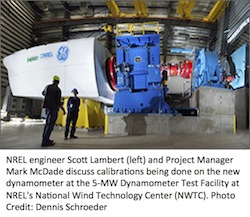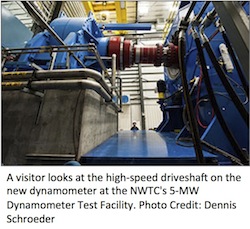Days before the holiday season, the Energy Department’s National Renewable Energy Laboratory (NREL) set the wind industry on a new course with the addition of a new 5MW Dynamometer Test Facility at its National Wind Technology Center (NWTC). The new facility will better enable NWTC engineers and their industry partners to verify the performance and reliability of wind turbine drivetrain prototypes and commercial machines. Increased performance and realiability will lead to more competitively cost wind energy.
The facility will be able to test virtually any land-based turbine in more “real time” conditions that turbines experience out on the “farm”.
“These new capabilities make this a very special facility, one of the largest and finest of its kind in the world,” said NWTC Director Fort Felker. “It gives NREL an enhanced ability to do comprehensive testing of modern multi-megawatt wind turbine systems in a laboratory environment to verify their performance and reliability before they are widely deployed.”
A dynamometer system replaces the rotor and blades of a wind turbine and allows researchers to control the turbine drivetrain’s mechanical and electrical systems while simulating normal and extreme operating conditions. Historically, this testing has been done under torque (rotating) loads only. However, the NWTC facility incorporates a non-torque loading s ystem into the testing regimen, a hydraulic device that allows for simulation of both the rotational and bending loads that a wind turbine rotor places on a drivetrain.
ystem into the testing regimen, a hydraulic device that allows for simulation of both the rotational and bending loads that a wind turbine rotor places on a drivetrain.
“The non-torque loading system is what really sets this facility apart from other comparable test sites,” explained NWTC Dynamometer Project Manager Mark McDade. “This allows us to test the drivetrain system with the types of loads that it will see in a real-world application. It’s a very important feature for a test apparatus because the adverse impacts these types of loads can have on a system are significant.”
The system features a 6-MW motor, which provides the power to a turbine during testing. The motor turns at very high speed and low torque. The motor drives a gearbox, which transforms the output to the high torque and low speed that is appropriate for a wind turbine drivetrain. This provides the rotating loads on the test article. Add to this motorized torque testing the non-torque loading capability unique to the NWTC, and NREL is able to put a wind turbine drivetrain through the most realistic loading tests possible in a laboratory.
“These machines are expected to operate reliably in the field, often in harsh conditions, for 20 years or more,” Felker said. “The ability to comprehensively test these systems in the lab, to verify their reliability and performance before they go into service, is a critically important capability for the wind industry.”
Another important new capability that enhances the value of the work being done at NREL’s 5-MW Dynamometer Test Facility is the Controllable Grid Interface (CGI), a powerful energy systems integration tool that allows engineers to precisely control the electrical grid conditions that a test article will see.
The CGI simulates various grid disturbances, such as over-voltage or under-voltage events, allowing engineers and industry partners to determine how grid-connected systems will react to these events in a controlled environment. This type of testing—performed offline from the grid, but simulating a real-world grid environment—enables users to verify performance, assure compliance with standards, and understand failures in a fraction of the time and cost that it takes to perform similar tests in the field.
The CGI can also help engineers determine how these systems will be able to provide ancillary services to the grid, as well as test and optimize the grid-integration-related performance of a unit before it is deployed.
 “This is a significant capability for NREL, and one that is very complementary to the work that will be done in the dynamometer,” McDade said. “As more and more renewable energy generation and storage technologies are added to our electricity mix, it is critically important that we understand how these systems will perform on the larger electric grid, how they will react to disturbances, and how they will be able to provide benefit to the grid from a systems integration standpoint.”
“This is a significant capability for NREL, and one that is very complementary to the work that will be done in the dynamometer,” McDade said. “As more and more renewable energy generation and storage technologies are added to our electricity mix, it is critically important that we understand how these systems will perform on the larger electric grid, how they will react to disturbances, and how they will be able to provide benefit to the grid from a systems integration standpoint.”
The CGI can test not only the integration performance of wind turbines, but also that of a wide variety of grid-integrated energy systems, such as utility-scale solar photovoltaic (PV) generation, PV inverters, and energy storage systems.
In addition to enabling deployment-readiness testing, the new NREL test facility will be able to examine future technology innovations, such as advanced drivetrain systems, that promise to usher in the next generation of higher-performance, lower-cost wind turbines.

